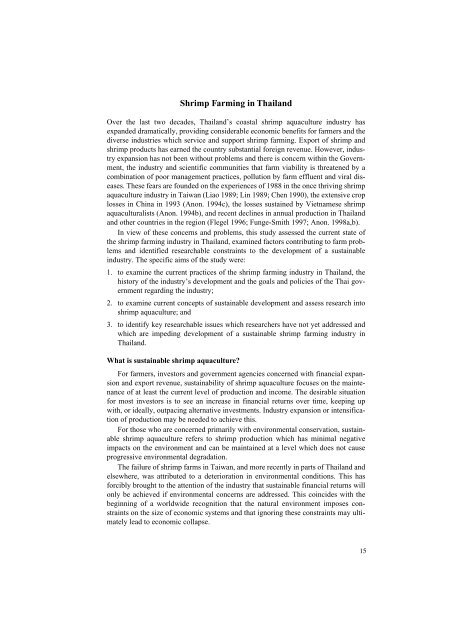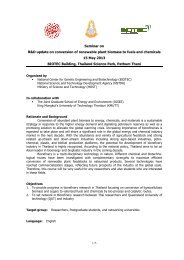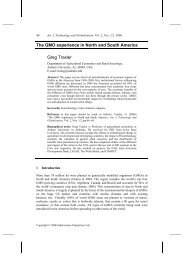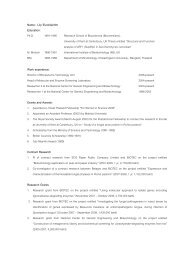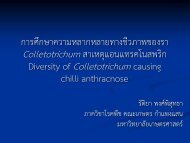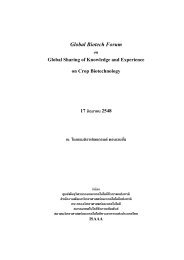!An Assessment of the Status of the <strong>Shrimp</strong>Farm<strong>in</strong>g Industry <strong>in</strong> <strong>Thailand</strong>Sue Jenk<strong>in</strong>s*, Paul T. Smith†, Siri Tookw<strong>in</strong>as§ and Michael J. PhillipsAbstractThe shrimp aquaculture <strong>in</strong>dustry <strong>in</strong> <strong>Thailand</strong> has expanded greatly over the last twodecades. There was a rapid expansion from 1988 to 1995 but more recently shrimpproduction has decreased and stabilised at around 234,000 t <strong>in</strong> 1998. In this chapter,the development of the shrimp farm<strong>in</strong>g <strong>in</strong>dustry <strong>in</strong> <strong>Thailand</strong> is reviewed.The development of shrimp farm<strong>in</strong>g <strong>in</strong> <strong>Thailand</strong> has generated substantial <strong>for</strong>eignrevenue from shrimp export, and associated <strong>in</strong>dustries have provided economic booststo the Thai economy. In rural areas, this has often resulted <strong>in</strong> improvements <strong>in</strong> <strong>in</strong>frastructure,such as roads and electricity supplies. Nevertheless, environmental degradationhas occurred where farms were located <strong>in</strong> unsuitable sites and where farmdensities exceeded the carry<strong>in</strong>g capacity of the environment. Although many have benefitedf<strong>in</strong>ancially through farm ownership or <strong>in</strong>dustry employment, there are caseswhere some have been disadvantaged or displaced by the <strong>in</strong>dustry.This review f<strong>in</strong>ds that research has often neglected many of the problems andissues that are faced by the shrimp farm<strong>in</strong>g <strong>in</strong>dustry. Much of the past and ongo<strong>in</strong>gresearch ef<strong>for</strong>ts have been largely directed toward solv<strong>in</strong>g production problems as theyhave arisen. Instances of crop failure have commanded the attention of most researchers,and hence water quality problems and disease syndromes have been focused upon.However, these crop failures are, <strong>in</strong> most <strong>in</strong>stances, symptoms of underly<strong>in</strong>g problemsrather than the cause of unsusta<strong>in</strong>ability. Hence, this review tries to identify keyresearchable constra<strong>in</strong>ts to development of a susta<strong>in</strong>able <strong>in</strong>dustry with the assistance ofmany em<strong>in</strong>ent people <strong>in</strong> <strong>Thailand</strong>, thus generat<strong>in</strong>g a list of 25 key issues <strong>for</strong> research.F<strong>in</strong>ally, many of the constra<strong>in</strong>ts and issues that have been identified are <strong>in</strong>terrelatedor <strong>in</strong>terdependent. This suggests that collaboration between researchers and l<strong>in</strong>kagesbetween projects will be essential to develop<strong>in</strong>g a susta<strong>in</strong>able shrimp farm<strong>in</strong>dustry. Hence, it is necessary <strong>for</strong> all those currently concerned with develop<strong>in</strong>g a susta<strong>in</strong>ableshrimp farm <strong>in</strong>dustry <strong>in</strong> <strong>Thailand</strong> to identify the gaps <strong>in</strong> the research ef<strong>for</strong>tsand to <strong>for</strong>mulate a coord<strong>in</strong>ated and <strong>in</strong>tegrated approach to future research. Thisapproach must be fitted with<strong>in</strong> the framework of the exist<strong>in</strong>g research bodies <strong>in</strong> <strong>Thailand</strong>.The benefit to <strong>Thailand</strong> of regional cooperation <strong>in</strong> such research is also recognised.* Tropical Forest <strong>Research</strong> Centre, Commonwealth Scientific and Industrial <strong>Research</strong> Organisation(CSIRO), PO Box 780, Atherton, Queensland 4883, Australia.† University of Western Sydney Macarthur, PO Box 555, Campbelltown, New South Wales 2560,Australia.§ <strong>Coastal</strong> <strong>Aquaculture</strong> Division, Department of Fisheries, Chatuchak, Bangkok 10900, <strong>Thailand</strong>. Network of <strong>Aquaculture</strong> Centres <strong>in</strong> Asia–Pacific (NACA), PO Box 1040, Kasetsart Post Office, Bangkok10903, <strong>Thailand</strong>.)#
!<strong>Shrimp</strong> Farm<strong>in</strong>g <strong>in</strong> <strong>Thailand</strong>Over the last two decades, <strong>Thailand</strong>’s coastal shrimp aquaculture <strong>in</strong>dustry hasexpanded dramatically, provid<strong>in</strong>g considerable economic benefits <strong>for</strong> farmers and thediverse <strong>in</strong>dustries which service and support shrimp farm<strong>in</strong>g. Export of shrimp andshrimp products has earned the country substantial <strong>for</strong>eign revenue. However, <strong>in</strong>dustryexpansion has not been without problems and there is concern with<strong>in</strong> the Government,the <strong>in</strong>dustry and scientific communities that farm viability is threatened by acomb<strong>in</strong>ation of poor management practices, pollution by farm effluent and viral diseases.These fears are founded on the experiences of 1988 <strong>in</strong> the once thriv<strong>in</strong>g shrimpaquaculture <strong>in</strong>dustry <strong>in</strong> Taiwan (Liao 1989; L<strong>in</strong> 1989; Chen 1990), the extensive croplosses <strong>in</strong> Ch<strong>in</strong>a <strong>in</strong> 1993 (Anon. 1994c), the losses susta<strong>in</strong>ed by Vietnamese shrimpaquaculturalists (Anon. 1994b), and recent decl<strong>in</strong>es <strong>in</strong> annual production <strong>in</strong> <strong>Thailand</strong>and other countries <strong>in</strong> the region (Flegel 1996; Funge-Smith 1997; Anon. 1998a,b).In view of these concerns and problems, this study assessed the current state ofthe shrimp farm<strong>in</strong>g <strong>in</strong>dustry <strong>in</strong> <strong>Thailand</strong>, exam<strong>in</strong>ed factors contribut<strong>in</strong>g to farm problemsand identified researchable constra<strong>in</strong>ts to the development of a susta<strong>in</strong>able<strong>in</strong>dustry. The specific aims of the study were:1. to exam<strong>in</strong>e the current practices of the shrimp farm<strong>in</strong>g <strong>in</strong>dustry <strong>in</strong> <strong>Thailand</strong>, thehistory of the <strong>in</strong>dustry’s development and the goals and policies of the Thai governmentregard<strong>in</strong>g the <strong>in</strong>dustry;2. to exam<strong>in</strong>e current concepts of susta<strong>in</strong>able development and assess research <strong>in</strong>toshrimp aquaculture; and3. to identify key researchable issues which researchers have not yet addressed andwhich are imped<strong>in</strong>g development of a susta<strong>in</strong>able shrimp farm<strong>in</strong>g <strong>in</strong>dustry <strong>in</strong><strong>Thailand</strong>.What is susta<strong>in</strong>able shrimp aquaculture?For farmers, <strong>in</strong>vestors and government agencies concerned with f<strong>in</strong>ancial expansionand export revenue, susta<strong>in</strong>ability of shrimp aquaculture focuses on the ma<strong>in</strong>tenanceof at least the current level of production and <strong>in</strong>come. The desirable situation<strong>for</strong> most <strong>in</strong>vestors is to see an <strong>in</strong>crease <strong>in</strong> f<strong>in</strong>ancial returns over time, keep<strong>in</strong>g upwith, or ideally, outpac<strong>in</strong>g alternative <strong>in</strong>vestments. Industry expansion or <strong>in</strong>tensificationof production may be needed to achieve this.For those who are concerned primarily with environmental conservation, susta<strong>in</strong>ableshrimp aquaculture refers to shrimp production which has m<strong>in</strong>imal negativeimpacts on the environment and can be ma<strong>in</strong>ta<strong>in</strong>ed at a level which does not causeprogressive environmental degradation.The failure of shrimp farms <strong>in</strong> Taiwan, and more recently <strong>in</strong> parts of <strong>Thailand</strong> andelsewhere, was attributed to a deterioration <strong>in</strong> environmental conditions. This has<strong>for</strong>cibly brought to the attention of the <strong>in</strong>dustry that susta<strong>in</strong>able f<strong>in</strong>ancial returns willonly be achieved if environmental concerns are addressed. This co<strong>in</strong>cides with thebeg<strong>in</strong>n<strong>in</strong>g of a worldwide recognition that the natural environment imposes constra<strong>in</strong>tson the size of economic systems and that ignor<strong>in</strong>g these constra<strong>in</strong>ts may ultimatelylead to economic collapse.)$
- Page 8 and 9: !The 1994 Workshop had a working hy
- Page 11 and 12: !The Workshop at Hat Yai, SongkhlaA
- Page 13: !ReferenceSmith, P.T., ed.. 1999. T
- Page 18 and 19: ! !Table 1. World production (# 1,0
- Page 20 and 21: !Domestic and world demandJapan is
- Page 22 and 23: !Intensification of farms has been
- Page 24 and 25: !no significant difference between
- Page 26 and 27: !Production Practices and Technique
- Page 28 and 29: !use water which is almost fresh (F
- Page 30 and 31: !mended quantities for application
- Page 32 and 33: !the biological processes in sedime
- Page 34 and 35: !factors (Fegan 1994). Environmenta
- Page 36 and 37: !Acid sulphate soils occur in most
- Page 38 and 39: during the rainy season, some deter
- Page 40 and 41: Land subsidenceCoastal land subside
- Page 42 and 43: first when an area becomes environm
- Page 44 and 45: !Administration. Their work has inv
- Page 46 and 47: agriculture, selects coastal land p
- Page 48 and 49: Sustainability, Sustainable Develop
- Page 50 and 51: cultural and environmental asset va
- Page 52 and 53: $+Table 12. (cont’d) Impediments
- Page 54 and 55: $#Table 12. (cont’d) Impediments
- Page 56 and 57: $%Table 12. (cont’d) Impediments
- Page 58 and 59: capacities of alternative organisms
- Page 60 and 61: sources. This is one of the greates
- Page 62 and 63: Table 13. (cont’d) Summary of the
- Page 64 and 65:
Boonyapiwat, S. 1989. Species of ph
- Page 66 and 67:
Katesombun, B. 1992. Aquaculture pr
- Page 68 and 69:
Sirisup, S. 1988 Socio-economic cha
- Page 70 and 71:
!In the preliminary analysis, the s
- Page 72 and 73:
!until all variables had been teste
- Page 74 and 75:
!quality problem over the past 3 ye
- Page 76 and 77:
!Figure 1. Characterisation of prov
- Page 78 and 79:
!Variables Contributing to Shrimp P
- Page 80 and 81:
!Figure 5. Relationship between ave
- Page 82 and 83:
!southern). The linear regression m
- Page 84 and 85:
!Appendix. Results of logistic regr
- Page 86 and 87:
!2) Trat ProvinceClassification tab
- Page 88 and 89:
!Chi-square df significanceModel Ch
- Page 90 and 91:
!8) Satun ProvinceClassification ta
- Page 92 and 93:
!Variables in the equationConstant
- Page 94 and 95:
!A total of 49 participants were in
- Page 96 and 97:
! ! ! ! ! ! ! ! ! ! ! ! ! ! ! ! !Fi
- Page 98 and 99:
!All issues are listed in Appendice
- Page 100 and 101:
!!were short term and one issue was
- Page 102 and 103:
!reared broodstock (issue 71). They
- Page 104 and 105:
!!Two participants commented that i
- Page 106 and 107:
mation transfer and training. This
- Page 108 and 109:
108Appendix 1. (cont’d) Descripti
- Page 110 and 111:
110Appendix 1. (cont’d) Descripti
- Page 112 and 113:
112Appendix 2. Descriptive statisti
- Page 114 and 115:
114Appendix 2. (cont’d) Descripti
- Page 116 and 117:
116Appendix 3. Descriptive statisti
- Page 118 and 119:
118Appendix 4. Descriptive statisti
- Page 120 and 121:
120Appendix 5. Descriptive statisti
- Page 122 and 123:
Appendix 5. (cont’d) Descriptive
- Page 124 and 125:
Appendix 7. Descriptive statistics
- Page 126 and 127:
Appendix 7. (cont’d) Descriptive
- Page 128 and 129:
128Appendix 8. (cont’d) Descripti
- Page 130 and 131:
!ParticipantsAustraliaDr Paul T. Sm


